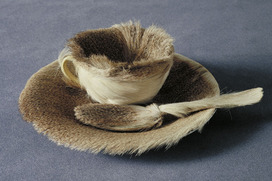
Have you ever listened to a sports event--say, a baseball game--on the radio? The sports announcer calls the play-by-play, while his associate, the "color commentator," adds additional facts to "add color" to the conversation. Good commentators enable listeners to "see" the game. To do the job well, these sportscasters have mastered the vocabulary of the sport--all the parts or "elements" of the game--and the rules or "principles" that govern how the elements of the game are put together. The same is true for art: to be a good "commentator" of art, you have to master the vocabulary (the parts or elements) and understand the rules (principles) by which the elements are put together.
Listen to a clip of Larry Munson, "Voice of the Dogs," calling game highlights for his (and MY) beloved Georgia Bulldogs. Imagine what his comments would be like if Larry didn't know anything about football. Munson is able to describe what's going on in the game because he understands the vocabulary and he knows the rules. If he didn't, the game wouldn't make sense to him and certainly not to his listeners.
Now listen to Peter Schickele ("PDQ Bach") acting as color commentator for Beethoven's Fifth Symphony. This may be the most unusual version of Beethoven's Fifth you've ever heard, but it's a wonderful demonstration of how knowing the vocabulary (the elements or parts) and the rules (principles) helps bring a subject alive. Both baseball and music have essential parts or elements and rules that govern how these elements should be used to make each meaningful. Without parts and rules to dictate how these parts should work together, the baseball game would be meaningless. And without parts and rules to govern them, music would be chaotic.
Art works the same way. Think of art as an event with its own vocabulary and rules. There are parts (elements) and rules (principles) that describe how the parts work together to form a meaningful event--a composition. When the player(s) use the parts according to the rules, an organized game results. When an artist uses the elements of art according to a ..........................
What are the "parts" of baseball--the essential elements needed to play the game? Let's make a list: a ball; a bat; 3 bases and a "home plate." What about players? Are uniforms essential? No, not really. Gloves? They're nice but not necessary. Now, can you play a game of baseball with these essential elements? Maybe you can play at baseball, but without some rules, you won't have a game, because a game requires rules that dictate how all the elements relate to each other.
Elements of art
1. Learn the elements by viewing the Powerpoint presentation "Elements" (For some reason the last 2 slides won't show in Vista; this is not a problem. Slide 16 is just a recap of the artwork; slide 17 is just references.)
2. Read "A quick reference guide to the elements of art." The small black rectangles are hyperlinks to images on the Web; be sure to visit the links! NOTE: If you have trouble opening the hyperlinks in the PDF, right-click on the link and choose "Copy location," then right-click and "Past" into your browser to open the link.
3. Learn the principles by viewing the Powerpoint presentation Principles of Design"
4. Read "Principles of composition." Again, the small black rectangles are hyperlinks to images on the Web; be sure to visit the links!
5. In realistic art works, the elements of art are used to describe nature as we naturally see it. But in abstract and non-objective art, these same elements, free from describing reality, can be used to express emotion, movement, or even to create a new reality. Study carefully the following images and how the elements are used (you'll use them in your "Talking about art" assignment):
Listen to a clip of Larry Munson, "Voice of the Dogs," calling game highlights for his (and MY) beloved Georgia Bulldogs. Imagine what his comments would be like if Larry didn't know anything about football. Munson is able to describe what's going on in the game because he understands the vocabulary and he knows the rules. If he didn't, the game wouldn't make sense to him and certainly not to his listeners.
Now listen to Peter Schickele ("PDQ Bach") acting as color commentator for Beethoven's Fifth Symphony. This may be the most unusual version of Beethoven's Fifth you've ever heard, but it's a wonderful demonstration of how knowing the vocabulary (the elements or parts) and the rules (principles) helps bring a subject alive. Both baseball and music have essential parts or elements and rules that govern how these elements should be used to make each meaningful. Without parts and rules to dictate how these parts should work together, the baseball game would be meaningless. And without parts and rules to govern them, music would be chaotic.
Art works the same way. Think of art as an event with its own vocabulary and rules. There are parts (elements) and rules (principles) that describe how the parts work together to form a meaningful event--a composition. When the player(s) use the parts according to the rules, an organized game results. When an artist uses the elements of art according to a ..........................
What are the "parts" of baseball--the essential elements needed to play the game? Let's make a list: a ball; a bat; 3 bases and a "home plate." What about players? Are uniforms essential? No, not really. Gloves? They're nice but not necessary. Now, can you play a game of baseball with these essential elements? Maybe you can play at baseball, but without some rules, you won't have a game, because a game requires rules that dictate how all the elements relate to each other.
Elements of art
1. Learn the elements by viewing the Powerpoint presentation "Elements" (For some reason the last 2 slides won't show in Vista; this is not a problem. Slide 16 is just a recap of the artwork; slide 17 is just references.)
2. Read "A quick reference guide to the elements of art." The small black rectangles are hyperlinks to images on the Web; be sure to visit the links! NOTE: If you have trouble opening the hyperlinks in the PDF, right-click on the link and choose "Copy location," then right-click and "Past" into your browser to open the link.
3. Learn the principles by viewing the Powerpoint presentation Principles of Design"
4. Read "Principles of composition." Again, the small black rectangles are hyperlinks to images on the Web; be sure to visit the links!
5. In realistic art works, the elements of art are used to describe nature as we naturally see it. But in abstract and non-objective art, these same elements, free from describing reality, can be used to express emotion, movement, or even to create a new reality. Study carefully the following images and how the elements are used (you'll use them in your "Talking about art" assignment):
- Masaccio's "Holy Trinity" (Renaissance) and read about the painting here.
- Picasso's "Les Demoiselles d'Avignon" (Cubism, early 20th century) and read about the painting here.
- Jackson Pollock's "Lavender Mist" (20th century Modern) and get to know Pollock by viewing "Jackson Pollock 51" (podcast) and "Jackson Pollock and Mark Rothko: Icons of Abstract Expressionism" (podcast)


